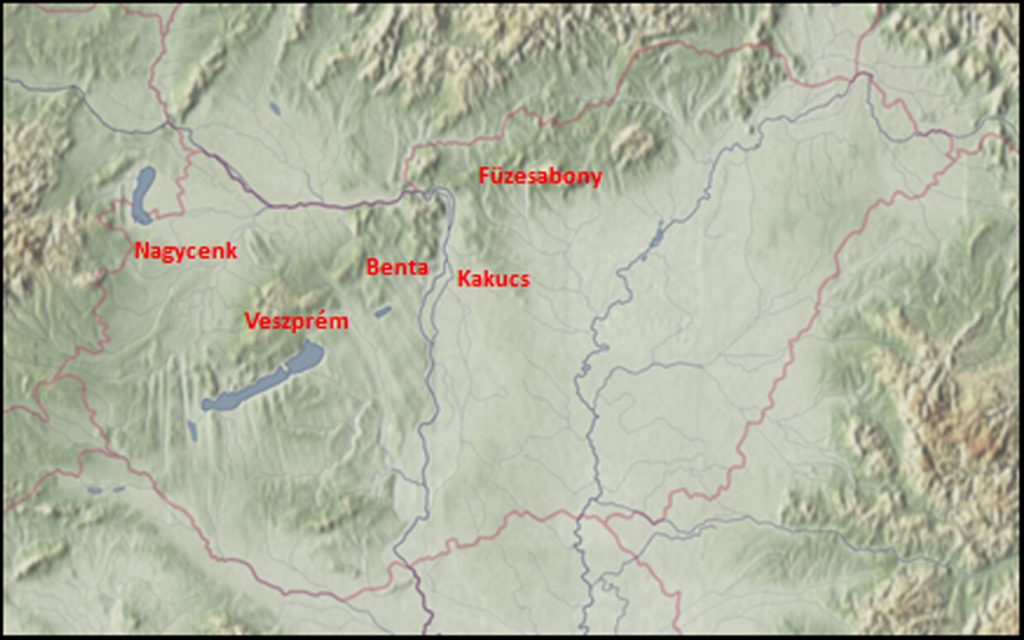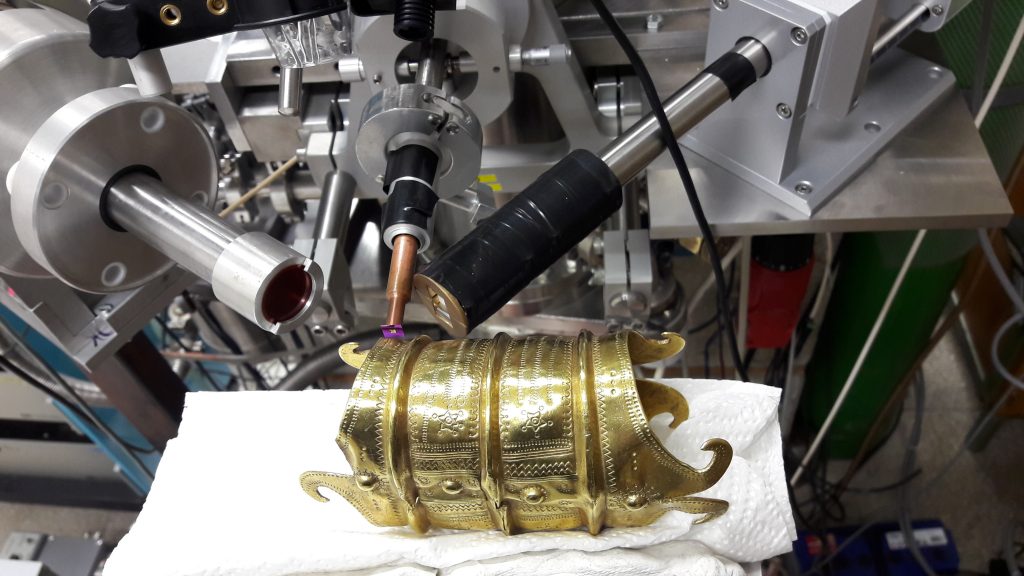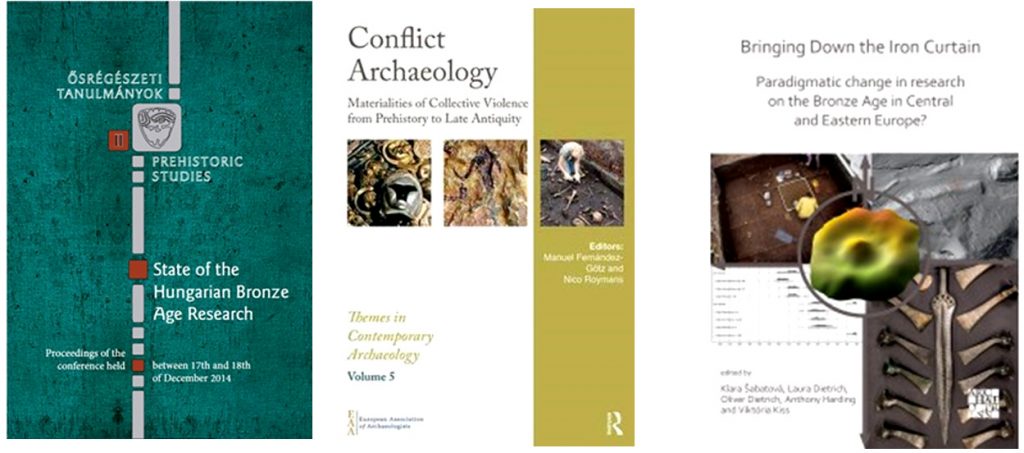The Momentum Mobility Research Group has completed its five-year research period with excellent qualifications
The work and final report of the Momentum Mobility Research Group, which has been operating at the Institute of Archeology of the Research Centre for the Humanities since July 2015, was rated excellent by professional reviewers, the commission and the Chair Committee for Scientific Evaluation.
Summary of research team leader Viktória Kiss about the results achieved in five years:
Mobility and Bronze Age Archeology – Current Issues and Results
In the last one and a half hundred years, the study of the movement of communities was an important direction in the research of Carpathian Bronze Age. The importance of the issue is also emphasized by contemporary migration phenomena. In the absence of written sources, it was only possible to induce from the objects the existence of interconnections of the Bronze Age (2600/2500-800 BC) communities previously. This prove the trade of bronze raw materials (copper and tin alloys), and artefacts, as well as the exchange of other precious (gold, amber) materials. The aim of the Momentum Mobility project was to examine (1) settlements, (2) burials, and (3) artefacts (weapons, jewelry, ceramics) found dates from the first thousand years of the Bronze Age (between 2500 and 1500 BC), in the Carpathian Basin there, by integrating new scientific analyses of archaeological finds, available in recent decades.
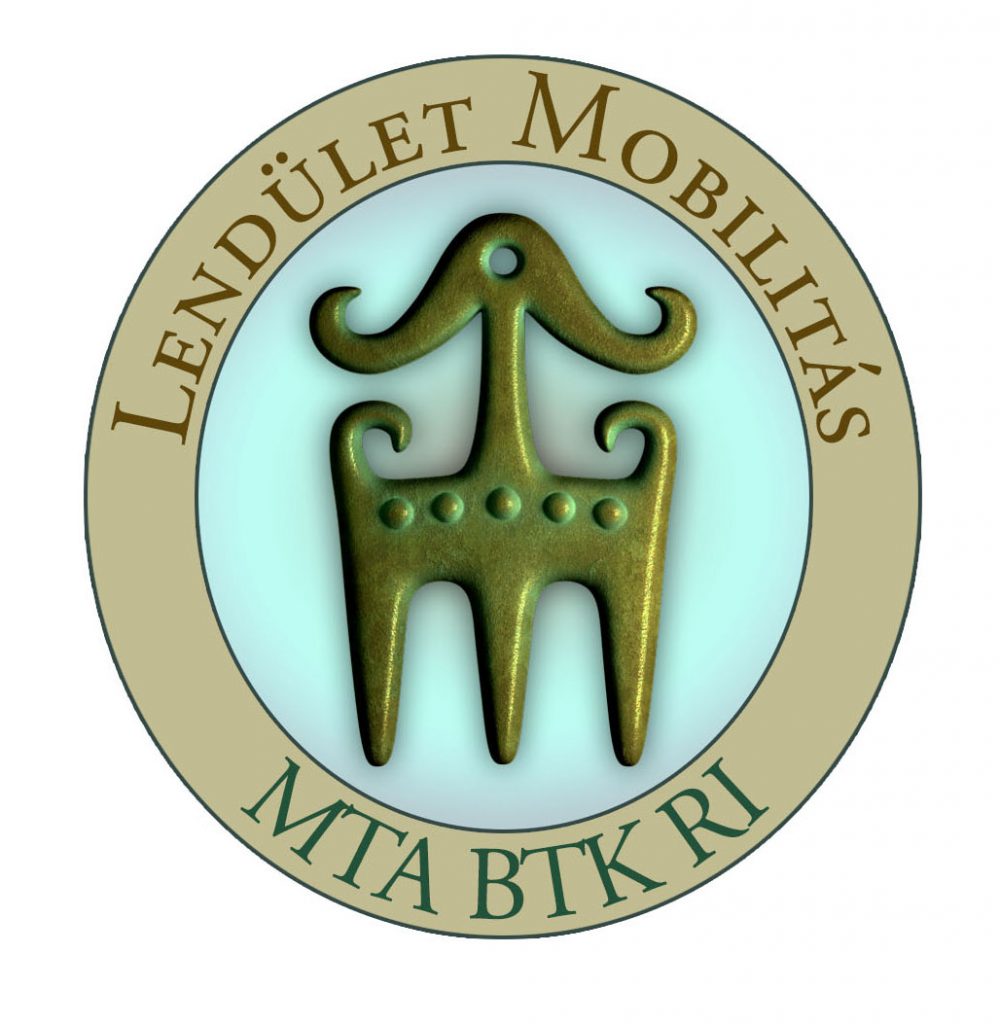
Our logo symbolizes the three basic pillars of our research, the examination of settlements, burials and artifacts, which is a modified version of a Bronze Age jewel (Graphics: Zsolt Réti)
Multidisciplinary – genetic, pathological, absolute dating, isotope geochemical and geophysical – methods, not used so far in the research of the period, provided new results in the mentioned thousand years, in the age of Greek heroes buried in chamber tombs lived people and communities of all sizes. The most important issue of our basic research is the mobility and stratification of contemporary society and the mapping of trade relations. Mobility can be interpreted more broadly than migration, covering several topics, such as marriage habits or even the movement of Bronze Age warriors. The basic question of the cooperation of archaeologists, archaeogeneticist, anthropologists, material scientists in our team is therefore who and what migrated: people or objects? How to separate objects that have been moved from one place to another through trade from those carried by the movement of families or communities. To answer these questions, we have selected five well-researched settlements from the central zone of the Carpathian Basin, the central, north-eastern and western regions of present-day Hungary and the surrounding micro-regions, which represent a significant sample area for the study of Bronze Age groups in Central Europe. Our results are summarized below according to the three main questions.
Sample areas of the Momentum Mobility Research Group
Can the migration of larger communities be demonstrated through the analysis of human remains and artefacts?
Strontium isotope sampling of the teeth of the deceased (carried out in collaboration with Quinnipiac and Yale Universities), buried in inhumation graves and settlement pits between 2500 and 1500 BC, prove that the proportion of non-locally born people reached 35-40% in several cases (Giblin et al. 2019). The analysis of samples taken from cremation graves, with the help of the Hungarian Academy of Sciences’ Distinguished Guest Scientist Fellowshop grant, provided similar data. This means that communities living in the first thousand years of the Bronze Age had high levels of mobility. We find a higher proportion of immigrants women, but among men and children there are also. This suggests that in the studied groups – similarly to the Bronze Age communities of Western and Central Europe – local men chose their wives from more distant communities, so the habit of exogamy was present, but we can also count with immigrant families. Our results also represent a step forward in the development of the strontium isotope map of Hungary, providing data that can be applied to other archaeological periods. Examination of burial practices and diseases provides additional information about the lifestyles of contemporaneous communities (Gömöri et al. 2018; Szeverényi, Kiss 2018).
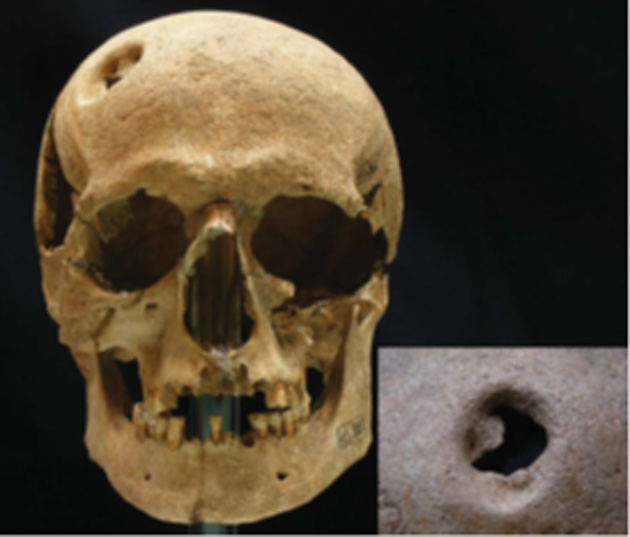
Trauma associated with combat injury on a skull excavated in Füzesabony (Source: Hungarian Natural History Museum)
In the case of the Early Bronze Age material associated with the Bell Beaker culture genetic studies clearly indicate the newly arrived communities in the region, characterized by previously unknown DNA haplogroups. Analyses, carried out in collaboration with the Archaeogenetics Laboratory, Archaeological Institute of the Research Centre for the Humanities and the Department of Genetics at Harvard University, confirm that the period under study was characterized by multidirectional mobility, distinct from the Neolithic migrations. The new artefact types (the so-called Bell Beaker package), associated with immigrants from the western part of Central Europe, can be found in the burial of individuals with 0% and 75% of steppe genetic component. According to this communities, that used specific elements of material culture around 2500 BC, may have had diverse genetic compositions, with individuals of local and non-local origin living together (Olalde et al. 2018). Similar acculturation phenomena can be observed in the later period.
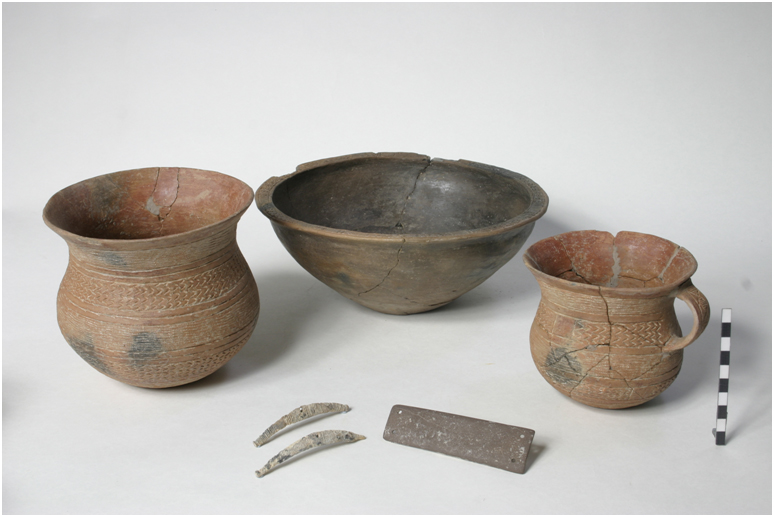
Finds of the Bell Beaker culture, analysed by the Archaeogenetic Laboratory of the Institute of Archeology of the Research Center for the Humanities (Source: Ferenczy Museum Center)
How did the technology of bronzeworking emerged, and where the raw materials used to make bronze objects come from in our area?
We have made important findings about the composition and fabrication techniques through non-destructive analyses in cooperation with the Centre for Energy Research and the Wigner Physics Research Center. Here we can mention that while the forging of the cutting edge of bronze axes with hammering after casting has been shown in the past by dectructive metallographic methods, our research prove hardening of the edge without destructive sampling (Kiss et al. 2015).
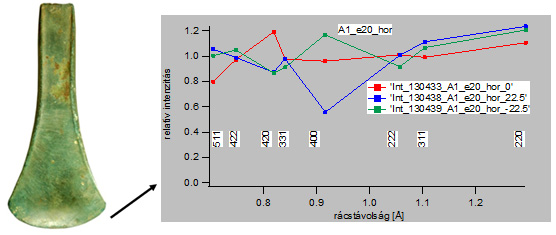
Time-of-flight neutron-diffraction analysis proving the forging of the flanged axe from the Zalaszabar hoard (Budapest Neutron Center)
The analysis of metal objects found in burials associated with the already mentioned Bell Beaker culture in Hungary, dating between 2500–2200 BC, confirmed that a uniform, so-called “Bell Beaker metal type” is not observable, so newly arrived communities of this culture used locally found ores. The raw material of most of the finds examined from the later period is the so-called Ösenring metal type, the characteristic fahlore of the region rich in antimony, arsenic and silver. Based on the preliminary results of lead isotope studies, this raw material can be derived from the region of Eastern Slovakia. At the end of the Middle Bronze Age in Hungary, the use of Eastern Alpine ores containing arsenic and nickel (but not silver) was typical (Dani et al. 2013; Maróti et al. 2017; Szentmiklósi et al. 2017). Tin, which is essential for tin bronze production, can be originated from the Czech-Saxon Ore Mountains or from Balkan sources, according to the ongoing tin isotope analyzes. In some cases we observed that the material of the rivets, used to fasten a tool or weapon (e.g. a dagger), is different from the material of the artefact. In such cases the dagger blade may have arrived as an import, which was fastened locally to the wooden handle.
Examination of a bronze dagger and its rivets from Füzesabony by 3D tomographic imaging method (Source: Centre for Energy Research)
Through what processes did the use of bronze change the history of the Carpathian Basin and the surrounding area, how did the institutionalization of social inequality develop?
A higher proportion of copper and bronze artefacts, symbolizing status, can be observed from the end of the Early Bronze Age after 2200 BC, and at the beginning of the Middle Bronze Age (Dani et al. 2016). Our research in collaboration with the Adam Mickiewicz University in Poznań (led by Mateusz Jaeger) and supported by the Polish Scientific Foundation, showed that amber finds as objects of prestige from Bronze Age sites in Hungary are of Baltic origin (Jaeger et al. 2020). This suggests that controlling the exchange of rare raw materials in this period may have been one of the possible ways to gain power. Studies of gold finds, carried out at the Heritage Science Laboratory of the Atomki, Debrecen, have revealed several sources of raw materials for gold (Dani et al. 2020).
PIXE study of a gold armband at the Atomki Heritage Laboratory in Debrecen (Source: Heritage Science Laboratory, Atomki)
In this later period, social inequalities became more significant, which was marked by bronze and gold artefacts, as well as multi-level settlement system (hilltop or hillfort settlements in addition to open villages). In the study of settlement hierarchy, our latest results suggest that socio-economic systems of different nature and structure operated in the studied regions of the Carpathian Basin (Dani et al. 2019a).
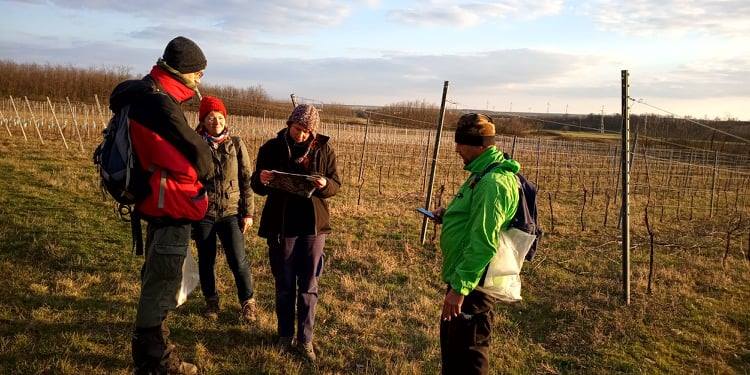
Field survey in the Nagycenk micro-region (Photo: Gabriella Kulcsár)
The application of multidisciplinary methods has brought important new results in the re-analysis of the findings and documentation of old and new excavations, for example in the digital processing of the 1930s excavation documentation of Füzesabony-Öregdomb (Gömöri et al. 2018; Jaeger et al. 2018; Niebieszczanski et al. 2019; Szathmári et al. 2019).
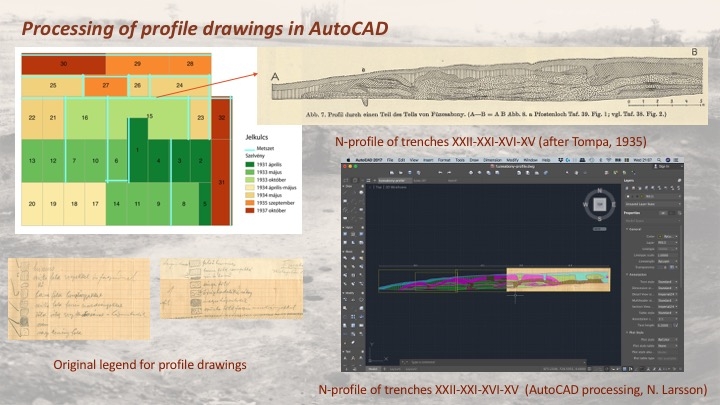
Digital processing of the excavation documentation of Füzesabony-Öregdomb, made by Ferenc Tompa in the 1930s, with a modern GIS method
In addition to macro-level analyzes, our complex studies with new methods also provided an opportunity to learn about the personal history of people connected to different levels of Bronze Age society. As examples we can mention one of the chiefs of the Balaton Uplands (Balatonakali), a woman who probably died in childbirth and was cremated with a seven-month-old fetus (Bonyhád), or a woman buried in a settlement pit with untreated trauma (Sóskút). With the help of these human remains and finds we were able to achieve the goal of our research program by moving “from bones, bronzes, and sites to society” (Kiss 2019, 2020).
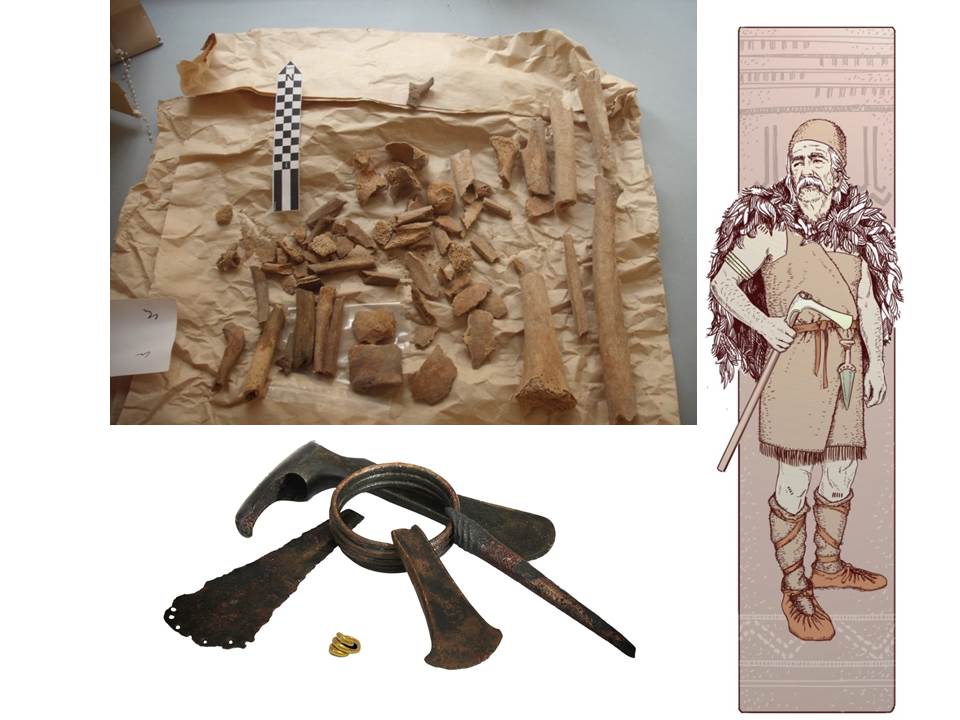
Human remains and finds from the chiefly burial excavated in Balatonakali, and the possible reconstruction of the high-status man (Photo: Kitti Köhler, Tamás Hajdu, Péter Hámori; graphics: Dávid Ringeisen)
Domestic and international collaborations, publications
Collaboration established within the former research network of the Hungarian Academy of Sciences contributed to the adaptation of new technologies: e.g. bioapatite-based radiocarbon dating of burnt bones at Atomki, in addition to collagen-based dating, and strontium isotope measurements of ashes (Major et al. 2018; Dani et al. 2019b; Giblin et al., 2019), and to increase the competitiveness of Hungarian scientific laboratories. New methods and international co-operations have made it possible for Hungarian Bronze Age research to participate on meetings and conferences among Europe’s leading research groups. This is shown by the fact that the video recording of our presentation at the international conference entitled Genes, isotopes and artefacts in Vienna in December 2018 has been viewed almost a thousand times on the YouTube channel of the OREA Institute of the Austrian Academy.
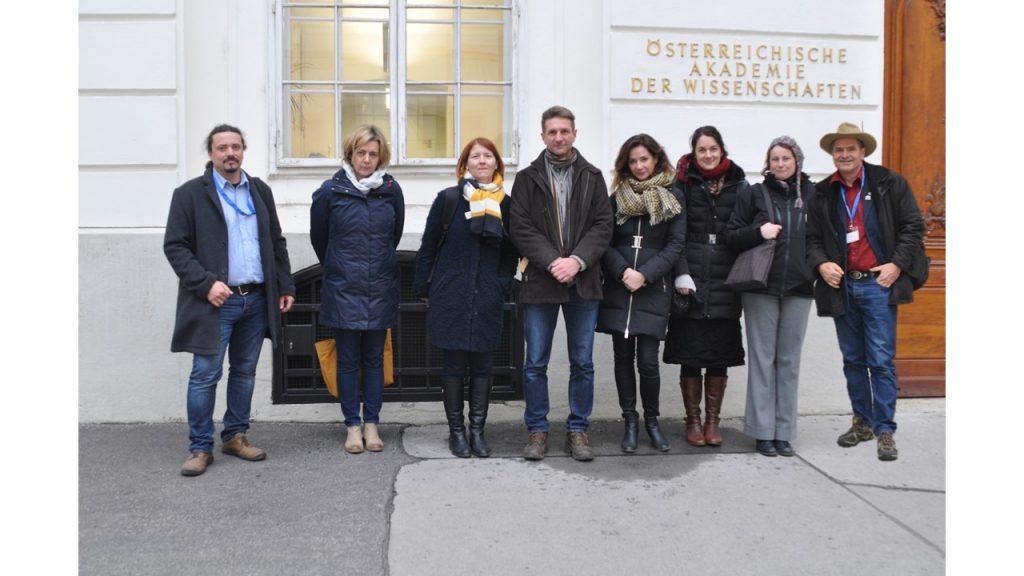
Members of our research group at the conference of the Austrian Academy of Science
The project was complemented by other winning applications and international collaborations: Bolyai scholarships (Anna Szécsényi-Nagy, Vajk Szeverényi, Tamás Hajdu), NKFIH ERC Mobile grant (Viktória Kiss), and PhD dissertations. We collaborate with several ERC research groups (Bronze Age Tin project, ERC Advanced Grant, University of Heidelberg; PEGASUS project, ERC Consolidator Grant, University of Toulouse; Motherhood in Prehistory, ERC Starting Grant, Austrian Academy of Sciences) and other international projects (EX-SPACE Marie Skłodowska-Curie Actions Fellowship Project, University of Durham; THESP Project, Danish National Museum and University of Gothenburg), expanding the analytical possibilities of the Bronze Age period discussed.
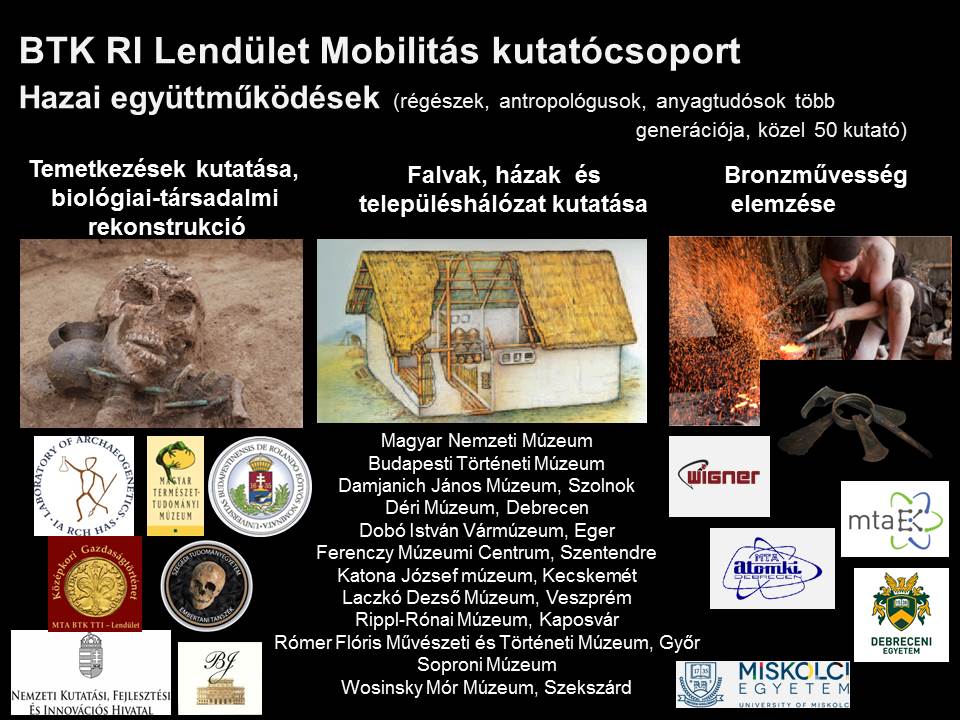
Our cooperating partners in Hungary
In addition to the analysis of Bronze Age crafts, conferences summarizing the multidisciplinary study of bronze working and textile making also contributed to the research of broader historical and archeological periods, organized in collaboration with the Institute of Archaeology, and with the Momentum Medieval Hungarian Economic History Research Team (Benkő–Kiss 2017; Kiss et al. 2017, 2020). For a similar purpose, we organized domestic and international workshops discussing the methodological issues of studying cremation burials and the research results of Bronze Age pottery production.
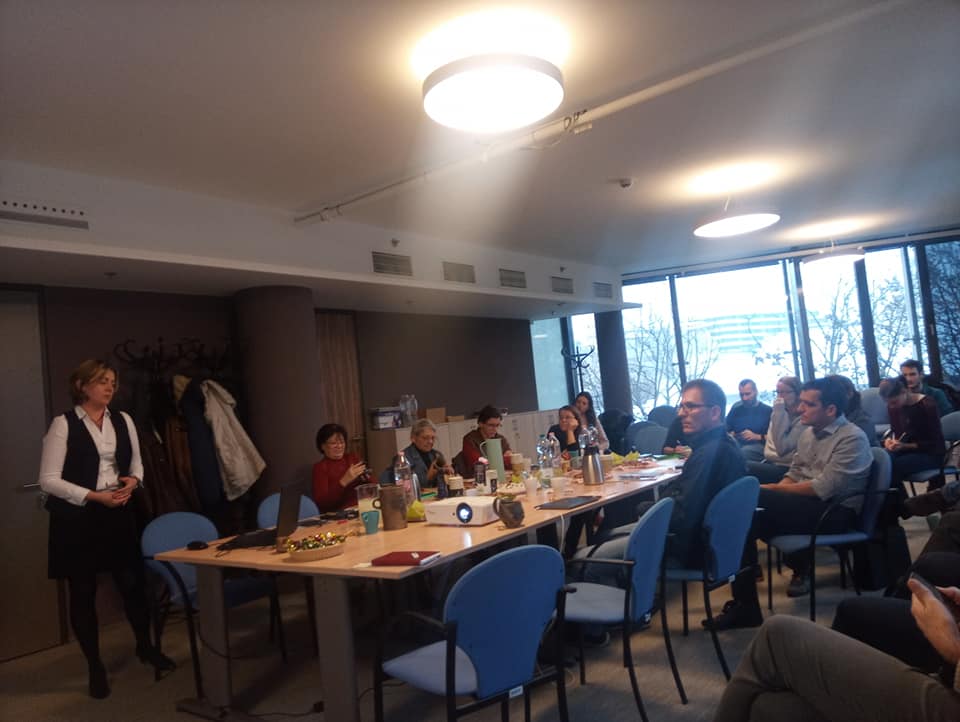
Closing workshop of the CRAFTER project about Bronze Age pottery production (Photo: Ágnes Király)
During the five years of the project, more than a hundred publications (59 book chapters, books, studies, including 21 in Hungarian and 38 in foreign languages; 50 abstracts: 13 in Hungarian, 37 in foreign languages) were published, among them papers in Nature, Radiocarbon, Journal of Archaeological Sience, Quarternary International, and in Acta Archaeologica Academiae Scientiarum Hungaricae, and Communicationes Archaeologicae Hungariae. Besides one hundred presentations were made (on 39 local conferences 54 lectures, and on 31 foreign conferences 46 presentations).
Beside books and papers published so far, we are preparing a study volume and monographic volumes in English, as well as a popular science book in Hungarian:
Gabriella Kulcsár – Zsolt Bernert – Marietta Csányi – János Dani – P. Klára Fischl – Erika Gál – Claudina Gerling – Julia Giblin – Tamás Hajdu – Gábor Ilon – Kitti Köhler – Eszter Melis – Marcella Nagy – Géza Szabó – Ildikó Szathmári – Vajk Szeverényi Zsuzsanna Zoffmann – Kiss Viktória: Analyzing Bronze Age burials and settlements from Hungary
Csányi Marietta: Das spätbronzezeitliche Gräberfeld von Jánoshida
Szathmári Ildikó: Middle Bronze Age tell-settlement at Füzesabony-Öregdomb
Kiss Viktória (ed.): Bronze Age Embodied
Organization of science, transfer of knowledge
In addition to scientific research, our goal is also the social utilization of knowledge. The research group’s website in Hungarian and English has been enriched with a great number of scientific articles and research-related news articles over the past years. The number of readers of our bilingual Facebook page is constantly growing, we currently have more than 750 followers. We made a short film entitled Bronze Age Mysteries, which presents the work of the research group; so far, 7220 views are reported on the YouTube channel of the film company Real Pictures Production. The film was shown several times on M5 television in 2018 and 2019. In April 2019 the film was screened at the XX. International Archaeological Film Festival at the National Museum in Belgrade, representing Hungary among German, Spanish, Greek, Russian, Ukrainian, Serbian, Montenegrin and Egyptian films.
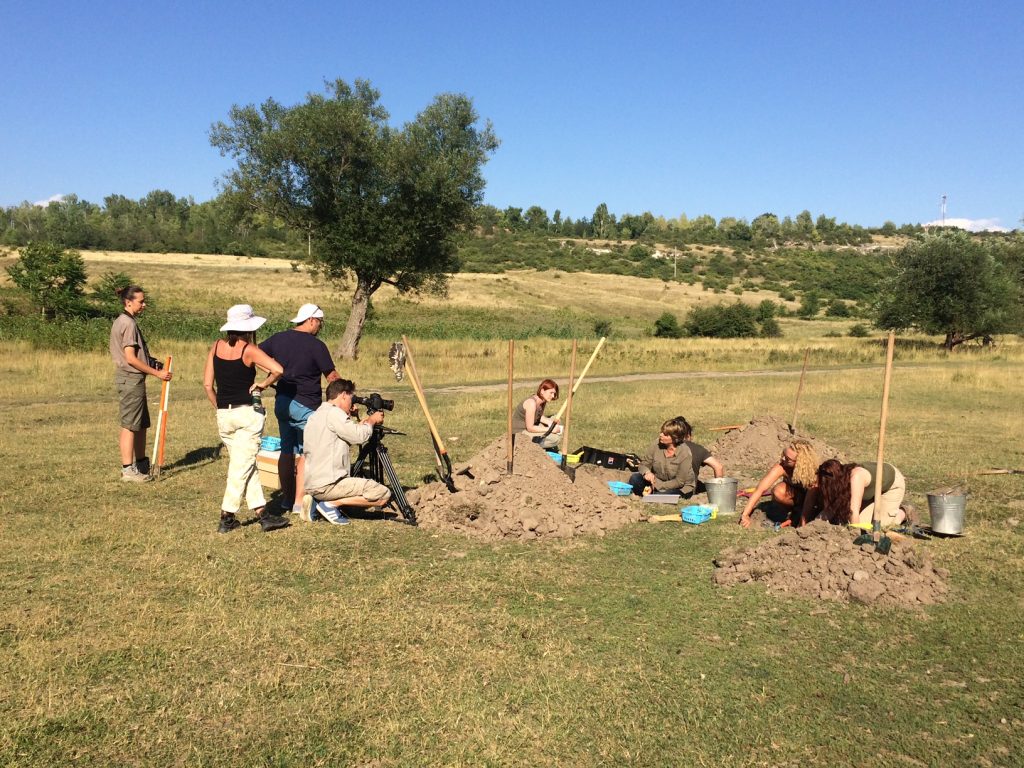
Filming of the short film Mysteries of the Bronze Age
We also took part in the making of another film in the European Union CRAFTER (Crafting Europe in the Bronze Age and Today) program launched in 2018 in collaboration with eight institutions from five European countries (Spain, Germany, Serbia, Hungary and the Netherlands). The aim of the film entitled In their Hands is to introduce European Bronze Age pottery and the help revive modern handicrafts. The film and the completed copies of the Bronze Age vessels could be seen in exhibitions held in the museums of five countries, in the Déri Museum in Debrecen, Hungary. The results of the project were also presented in a booklet in Hungarian and English (Dani, Kulcsár 2019) and at a workshop held at the Research Center for the Humanities. The exhibition of the CRAFTER project at the Déri Museum in Debrecen. Our professional work was reported in the media, mainly in connection with the publication of Nature articles with the participation of the research group, as well as in connection with the mentioned films and exhibition. Most recently, a summary of the results of the research group were among the leading news of mta.hu, and in the Ásatalk Podcast.
References
Benkő E., Kiss V.: Bronzművesség az őskortól a középkorig – műhelykonferencia/Bronzeworking from prehistoric times to the Middle Ages – Workshop. Magyar Régészet 2016 Tél/Hungarian Archaeology 2016 Winter.
Dani J., Török Zs., Csedreki L., Kertész Zs., Szikszai Z.: A hajdúsámsoni kincs PIXE vizsgálatának tanulságai. Gesta 12 (2013) 30–47.
Dani, J., P. Fischl, K.,Kulcsár,G., Szeverényi, V., Kiss, V.: Visible and invisible inequality in Early and Middle Bronze Age Hungary. In: Meller, H.–Hahn, H.-P.–Jung, R.–Risch, R. (Hrsg.): Arm und Reich–Zur Ressourcenverteilung in prähistorischen Gesellschaften / Rich and Poor–Competing for resources in prehistoric societies). 8. Mitteldeutscher Archäologentag vom 22. bis 24. Oktober 2015 in Halle (Saale). Tagungen des Landesmuseums für Vorgeschichte Halle 14. Halle (Saale) 2016, 219–242.
Dani, J., P. Fischl, K., Kulcsár, G., Szeverényi, V., Kiss, V.: Dividing space, dividing society: fortifiedsettlements in the Carpathian Basin (c. 2300–1500 BC).In: Meller, H.–Friedrich, S.–Küßner, M.–Stäuble,H.–Risch, R. (Hrsg.): Siedlungsarchäologie des Endneolithikums und der frühen Bronzezezeit / Late Neolithic and Early Bronze Age Settlement Archaeology 11. Mitteldeutscher Archäologentag vom 18. bis 20. Oktober 2018 in Halle (Saale) / 11th Archaeological Conference of Central Germany October 18–20, 2018 in Halle (Saale). Tagungen des Landesmuseums für Vorgeschichte Halle 20. Halle (Saale) 2019, 851–868.
Dani, J., Kulcsár G., Major, I., Melis, E., Patay, R., Szabó, G., Váczi, G., Kiss, V.: Case studies for the dating of Bronze Age cremation burials from Hungary. In: Palincaş, N. and Ponta, C. C.(eds): Bridging Science and Heritage in the Balkans: Studies in archaeometry, cultural heritage restoration and conservation. Proceedings of the Fifth Balkan Symposium of Archaeometry 2016, Sinaia, Romania. Oxford 2019, 29–37.
Dani, J., Márkus, G., Pernicka, E.: The Hajdúsámson hoard – revisited. In: Šabatová, K., Dietrich, L., Dietrich, O., Harding, A., Kiss, V. (eds.): Bringing Down the Iron Curtain: Paradigmatic Change in Research on the Bronze Age in Central and Eastern Europe? Oxford 2020, 11–27.
Dani J., Kulcsár G. (eds.): Európai kézművesség a bronzkorban és ma / Crafting Europe in the Bronze Age and Today. Kiállítási katalógus / Exhibition catalogue. Debrecen 2019.
Jaeger, M., Kulcsár, G., Taylor, N., Staniuk, R. (eds.): Kakucs-Turján Middle Bronze Age multi-layered fortified settlement in Central Hungary. Studien zur Archäologie in Ostmitteleuropa/Studia nad Pradziejami EuropyŚrodkowej Band 18. Bonn: Verlag Dr Rudolf Habelt GmbH 2018.
Jaeger, M., Czebreszuk, J., Piszora, P., Kulcsár, G.: Small Links in a Long Chain. Amber Finds at a Vatya Culture Fortified Settlement, Kakucs-Turján (Central Hungary). In: Maran, J., Băjenaru, R., Ailincăi, S.-C., Popescu, A.-D., Hansen, S. (eds.): Objects, Ideas and Travelers. Contacts between the Balkans, the Aegean and Western Anatolia during the Bronze and Early Iron Age, Volume to the Memory of Alexandru Vulpe. Proceedings of the Conference in Tulcea. Bonn 2020, 43–52.
Giblin, J., Ayala, D. Czene, A., Csányi, M. Dani, J., Endrődi, A., Fábián, Sz., Hajdu, T , Köhler, K. Kulcsár, G., Melis, E., Patay, R. Szabó, G., Szécsényi-Nagy, A., Szeverényi, V., Kiss, V.: Bronze Age Burials from the Carpathian Basin: New Isotope Results (poszter). SAA 84th Annual Meeting, Albuquerque, New Mexico, U.S., 2019. April 10–14. Program book. Albuquerque 2019, 100.
Gömöri, J., Melis, E., Kiss, V. 2018: A cemetery of the Gáta–Wieselburg Culture at Nagycenk (WesternHungary). Acta Archaeologica Academiae Scientiarum Hungaricae 69 (2018) 5–82.
Kiss V.: Megtestesült bronzkor. In: Ilon G. (szerk.): Régészeti nyomozások 2.0. Budapest 2019, 111–120.
Kiss, V.: The Bronze Age burial from Balatonakali revisited. In: Maran, J., Sorin-Christian, A., Bajenaru, R., Hansen, S. (eds.): Objects, Ideas and Travelers. Contacts between the Balkans, the Aegean and Western Anatolia during the Bronze Age and Early Iron Age. Conference to the Memory of Alexandru Vulpe. 10th-13th November 2017, Tulcea, Romania. Tulcea 2020, 553–568.
Kiss, V., Kasztovszky, Zs., Káli, Gy., Maróti, B., Pusztainé Fischl, K., Horváth, E., Szabó, G.: Non-destructive analyses of bronze artefacts from bronze age hungary using neutronbasedmethods. Journal of Anatomical Atomic Spectrometry 30 (2015) 685–693.
Kiss V., Pásztókai-Szeőke J., Weisz B.: Mixtura texturalis. Ember és textil a Kárpát-medencében/ Mixtura texturalis. People and Textiles in the Carpathian Basin. Magyar Régészet 2017. tavasz / Hungarian Archaeology 2017 Spring
Kiss V., Pásztókai-Szeőke J., Weisz B. (eds.): Mixtura texturalis II. Ember és textil a Kárpát-medencében. Az MTA BTK RI Lendület Mobilitás kutatócsoport és az MTA BTK TTI Lendület Középkori Magyar Gazdaságtörténet Kutatócsoport közös konferenciája. 2018. október 30-31. Ansztrakt kötet. Budapest 2018.
Major, I., Dani, J., Kiss, V., Melis, E., Patay, R., Szabó, G., Hubay, K., Futó, I., Huszánk, R., Molnár, M.:Adoption and evaluation of a sample pre-treatment protocol for radiocarbon dating of cremated bones at HEKAL. Radiocarbon 61 (2019) 159–171.
Maróti, B., Harsányi, I., Kasztovszky, Zs: Non-destructive analysis of bronze objects from Füzesabony-Öregdomb. Communicationes Archaeologicae Hungariae 2017, 81–84.
Niebieszczański, J., Jaeger, M., Pető, Á., Hildebrandt-Radke, I., Kulcsár, G., Staniuk, R., Taylor, N., Czebreszuk, J.: Revealing the internal organization of a Middle Bronze Age fortified settlement in Kakucs-Turján through geoarchaeological means: Magnetometric survey and sedimentological verification of ahousing structure. Journal of Archaeological Science: Reports 25 (2019) 409–419.
Olalde, I.,Brace, S.,Allentoft, M. E.,Armit, I.,Kristiansen, K.,Rohland, N.,Mallick, S.,Booth, T.,Szécsényi-Nagy, A.,Mittnik, A.,Altena, E.,Lipson, M.,Lazaridis, I.,Patterson, N. J.,Broomandkhoshbacht, N.,Diekmann, Y.,Faltyskova, Z.,Fernandes, D. M.,Ferry, M.,Harney, E.,deKnijff, P.,Michel, M.,Oppenheimer, J.,Stewardson, K.,Barclay, A.,Alt, K. W.,Fernández, A. A.,Bánffy,E., Bernabò-Brea, M.,Billoin, D.,Blasco, C.,Bonsall, C.,Bonsall, L.,Allen, T.,Büster, L.,Carver, S.,Castells Navarro, L.,Craig, O. E.,Cook, G. T.,Cunliffe, B.,Denaire, A.,Dinwiddy, K. E.,Dodwell, N.,Ernée, M.,Evans, C.,Kuchařík, M.,Farré, J. F.,Fokkens, H.,Fowler, C.,Gazenbeek, M.,Pena, R. G.,Haber-Uriarte, M.,Haduch, E.,Hey, G.,Jowett, N.,Knowles, T.,Massy, K.,Pfrengle, S.,Lefranc, P.,Lemercier, O.,Lefebvre, A.,Maurandi, J. L.,Majó, T.,McKinley, J. I.,McSweeney, K.,Mende, B. G.,Modi, A.,Kulcsár, G.,Kiss, V., Czene, A.,Patay, R.,Endródi, A.,Köhler, K.,Hajdu, T.,Cardoso, J. L.,Liesau, C.,Parker Pearson, M.,Włodarczak, P.,Price, T. D.,Prieto, P.,Rey, P.-J.,Ríos, P.,Risch, R.,RojoGuerra, M. A.,Schmitt, A.,Serralongue, J.,Silva, A. M.,Smrčka, V.,Vergnaud, L.,Zilhão, J.,Caramelli,D.,Higham, T.,Heyd, V.,Sheridan, A.,Sjögren, K.-G.,Thomas, M. G.,Stockhammer, P. W.,Pinhasi, R.,Krause, J.,Haak, W.,Barnes, I.,Lalueza-Fox, C.,Reich, D.: The Beaker Phenomenon And The Genomic Transformation Of Northwest Europe. Nature 2018 Mar 8; 555 (7695) 190-196. doi: 10.1038/nature25738
Szathmári, I., Guba , Sz., Kulcsár, G., Serlegi, G., Vágvölgyi, B.: Füzesabony-Öregdomb Bronze Age Tell Settlement – New Insights on the Settlement Structure. In: Fischl, K., Kienlin, T. (eds.): Beyond Divides – The Otomani-Füzesabony Phenomenon. Current Approaches to Settlement and Burial in the North-eastern Carpathian Basin and Adjacent Areas. UPA 345. Bonn 2020, 351-368.
Szentmiklósi, L., Kis, Z., Maróti, B., Kasztovszky, Zs.: Integration of neutron-based elemental analysis and imaging methods and applications to cultural heritage research. Review article. Journal of Archaeological Science Reports 20 (2018) 476–482.
Szeverényi, V., Kiss, V.: Material evidence forwarfare in Early and Middle Bronze Age Hungary. In:Fernández-Götz, M., Roymans, N. (eds.): Conflict Archaeology: Materialities of Collective Violence in Late Prehistoric and Early Historic Europe.Themes in contemporary archaeology–EAA Monographs Serie s. Oxford 2018, 37–49.








